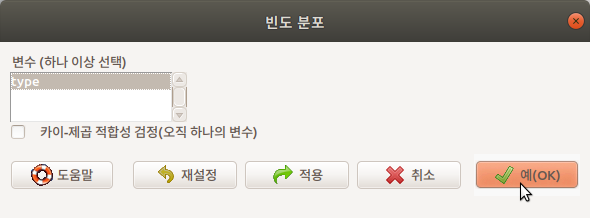통계 > 요약 > 빈도 분포...
Statistics > Summaries > Frequency distributions...


type 변수를 선택하고 예(OK)를 누른다. Prestige 데이터셋의 type 변수의 빈도를 보는 명령문이 다음과 같이 입력창에 기록되고 출력창에 빈도 정보가 출력된다:


더보기
Q1> Prestige의 변수는 여러개가 있습니다. 그중에서 왜 type만 선택 창에 나오나요?
type 변수는 factor 유형입니다. 빈도는 factor 유형의 변수만 셀 수 있기 때문입니다.
> str(Prestige) # Prestige 데이터셋의 변수 유형 살펴보기
?table # base 패키지의 table 도움말 보기
require(stats) # for rpois and xtabs
## Simple frequency distribution
table(rpois(100, 5))
## Check the design:
with(warpbreaks, table(wool, tension))
table(state.division, state.region)
# simple two-way contingency table
with(airquality, table(cut(Temp, quantile(Temp)), Month))
a <- letters[1:3]
table(a, sample(a)) # dnn is c("a", "")
table(a, sample(a), deparse.level = 0) # dnn is c("", "")
table(a, sample(a), deparse.level = 2) # dnn is c("a", "sample(a)")
## xtabs() <-> as.data.frame.table() :
UCBAdmissions ## already a contingency table
DF <- as.data.frame(UCBAdmissions)
class(tab <- xtabs(Freq ~ ., DF)) # xtabs & table
## tab *is* "the same" as the original table:
all(tab == UCBAdmissions)
all.equal(dimnames(tab), dimnames(UCBAdmissions))
a <- rep(c(NA, 1/0:3), 10)
table(a) # does not report NA's
table(a, exclude = NULL) # reports NA's
b <- factor(rep(c("A","B","C"), 10))
table(b)
table(b, exclude = "B")
d <- factor(rep(c("A","B","C"), 10), levels = c("A","B","C","D","E"))
table(d, exclude = "B")
print(table(b, d), zero.print = ".")
## NA counting:
is.na(d) <- 3:4
d. <- addNA(d)
d.[1:7]
table(d.) # ", exclude = NULL" is not needed
## i.e., if you want to count the NA's of 'd', use
table(d, useNA = "ifany")
## "pathological" case:
d.patho <- addNA(c(1,NA,1:2,1:3))[-7]; is.na(d.patho) <- 3:4
d.patho
## just 3 consecutive NA's ? --- well, have *two* kinds of NAs here :
as.integer(d.patho) # 1 4 NA NA 1 2
##
## In R >= 3.4.0, table() allows to differentiate:
table(d.patho) # counts the "unusual" NA
table(d.patho, useNA = "ifany") # counts all three
table(d.patho, exclude = NULL) # (ditto)
table(d.patho, exclude = NA) # counts none
## Two-way tables with NA counts. The 3rd variant is absurd, but shows
## something that cannot be done using exclude or useNA.
with(airquality,
table(OzHi = Ozone > 80, Month, useNA = "ifany"))
with(airquality,
table(OzHi = Ozone > 80, Month, useNA = "always"))
with(airquality,
table(OzHi = Ozone > 80, addNA(Month)))'Statistics > Summaries' 카테고리의 다른 글
| 6. Correlation matrix... (0) | 2022.02.13 |
|---|---|
| 5. Table of Statistics... (0) | 2022.02.13 |
| 4. Count missing observations (0) | 2022.02.13 |
| 2. Numeric summaries... (0) | 2022.02.13 |
| 1. Active Data set (0) | 2022.02.13 |